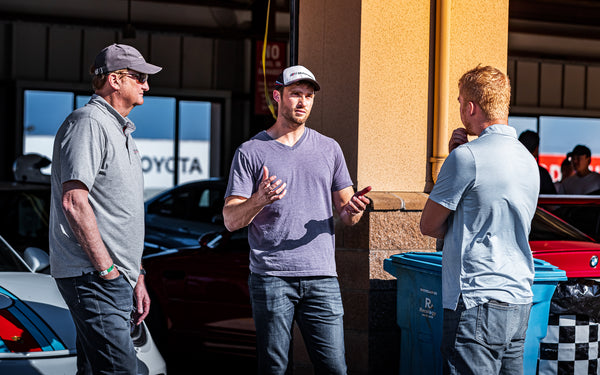Welcome To The Lightspeed Novice Program!

0. What Can You Expect at Our Novice Program?
Our program is designed to help you get faster in a safe and controlled environment. This means we'll be emphasizing attention to detail, situational awareness, smoothness on track, and the application of proven driving techniques. Remember, this isn't about outright speed or comparing yourself to others. By focusing on the fundamentals, you'll find that speed will naturally improve, and you'll be able to drive quicker than you might expect.
Here's what you can expect during the day:

Classroom Sessions: Before each on-track session, we'll have classroom meetings. In the morning, our primary focus will be on safety, including the location and meaning of track flags. Throughout the day, we'll delve into proven driving techniques such as understanding the traditional driving line, navigating corners effectively, and track etiquette, including safe passing procedures.
Professional Instruction: You will be paired with a professional instructor who will provide guidance throughout the day.*
First Session: Your instructor will lead you in a lead-follow format to help you learn the track layout, the location of flag stations, and how to navigate the traditional driving line.
Second Session: The lead-follow will continue at a higher pace, with a focus on identifying braking points, turn-in points, apexes, and track-out points in each corner.
Remaining Sessions: For the rest of the day, you'll have solo track time while your instructor observes from their own car on track, providing feedback and support.
1. Preparation Before the Track Day
For the Driver
- Helmet: Ensure you have a Snell 2015 or newer certified helmet.
- Clothing: Wear comfortable, non-flammable clothing.
- Shoes: Shoes with narrow, thin soles (like Vans, wrestling shoes, or driving shoes) are recommended for optimal pedal feel.
- Other: Bring sunscreen and plenty of water. You may also want to bring personal comfort items like a hat or a folding chair.
For the Car
- We encourage you to bring your unmodified street car. If your car has modifications, that's fine too. The focus is on improving your driving.
- Your car must be in mechanically sound condition with no error codes and be up to date on all service and maintenance. Check that your steering wheel has minimal play and doesn't vibrate excessively while driving. Ensure your tires have adequate tread, and your brakes are in good working order.
See this tech inspection guide [link]. - We recommend having a qualified mechanic perform a track inspection before the event.
Many mechanics will perform these inspections for free. Consider having them flush the brake fluid with a higher temp product (example). - You will need to have numbers, at least 8 inches tall, on both sides of your car, painters tape works well for this or you may consider the LightSpeed Number Plates for a better look on camera.
- After track sessions, avoid using your parking brake to prevent potential brake damage. Consider bringing tire chocks (example).
- Consider other basic tools such as a rechargeable air pump (example), tire pressure gauge (example), torque wrench (example) and the appropriate size lug nut socket, extra oil, cleaning supplies, etc.
2. Track Rules and Etiquette
The race track, including the pit lane, is a one-way road. Stopping or going in the opposite direction on the race track is strictly prohibited.
Flags are the primary means of communication on track, so understanding their meaning and your required response is critical. We will cover these in detail during the morning classroom session, but please familiarize yourself with the following:
- Green: Track is hot, driving at speed is permitted.
- Yellow: Caution, slow down, no passing. Resume normal speed and passing after the incident and when the next flag station is not displaying yellow.
- Red: Emergency situation, come to a safe and controlled stop off the driving line, within view of a flag station. Resume driving when the red flag is no longer displayed, following the instructions of the next flag.
- Black: Exit the track via the hot pit lane to the grid marshal. This could be for an individual infraction or for all cars. Follow instructions from officials before returning to your parking spot.
- Black with orange dot (meatball): Mechanical issue with your car, come into the hot pits to speak with the grid marshal.
- Blue flag (with yellow stripe): Advisory, faster cars are approaching. Stay on the driving line and give a point-by to allow them to pass in designated passing zones.
- Yellow/Red stripe: Advisory, debris on track (usually displayed for one lap).
- White: Advisory, slower vehicle (participant or emergency vehicle) on track.
- Checkered flag: Session over, exit at the pit entrance and return to your parking spot. Pull in straight and do not use your parking brake. This is a good time to check your tire pressures.
b. Follow the Rules:
- Always follow the directions of instructors, officials, and marshals.
- Remember this is not racing; show respect for fellow participants and avoid aggressive driving.
- Passing in the Novice group: Passing is only allowed in designated passing zones, and you must receive a clear point-by from the car ahead before passing. If you are a slower car, please monitor your mirrors in passing zones and provide point-bys to faster cars. Passing zones will be discussed in the morning session.
- Please review the FAQs
3. Track Talk
Experience the thrill of high-performance driving like never before with LightSpeed's exclusive and complimentary online TrackTalk webinar series. .

Sonoma Raceway

Thunderhill Raceway East

Laguna Seca Raceway

4. Driving Tips
- Start Slow, Focus on Technique: We'll build speed safely as your experience grows throughout the day.
- Smoothness and Vision: We aim to perfect smooth inputs on the controls and the ability to look far ahead and through corners.
- The Traditional Driving Line: This is the standard, safe line around the track that maximizes corner radius.
- Anatomy of a Corner: We'll discuss braking, turn-in, apex, and track-out and how consistency in these areas builds a foundation for safely increasing speed.
- Slow-in and Fast-out: Focus on smooth braking, consistent turn-in to hit the apex, and a smooth unwinding of the wheel with throttle application from apex to track out.
- Avoid Early Turn-In: Be patient and turn in at the correct point to ensure proper car rotation and avoid having to excessively slow down after the apex.
- Your instructor will be there to work with you and provide specific guidance on these techniques as they apply to different parts of the track.
5. After Each Driving Session
- If you've been braking heavily, take a slow cool-down lap in the paddock to help cool your brakes. Avoid parking with extremely hot brakes.
- Chock your tires and do not use your parking brake.
- Check your tire pressures and adjust them to the manufacturer's recommended cold pressures (found on your driver's side doorjamb). If you lowered pressures for the track, remember to reinflate them before driving on the street. A portable air compressor is highly recommended.
- Please join us back in the classroom after each session with your water! This is a valuable time to discuss how the session went and ask any questions you may have. Remember, there are no "stupid" questions, and it's a great way for everyone to learn.
